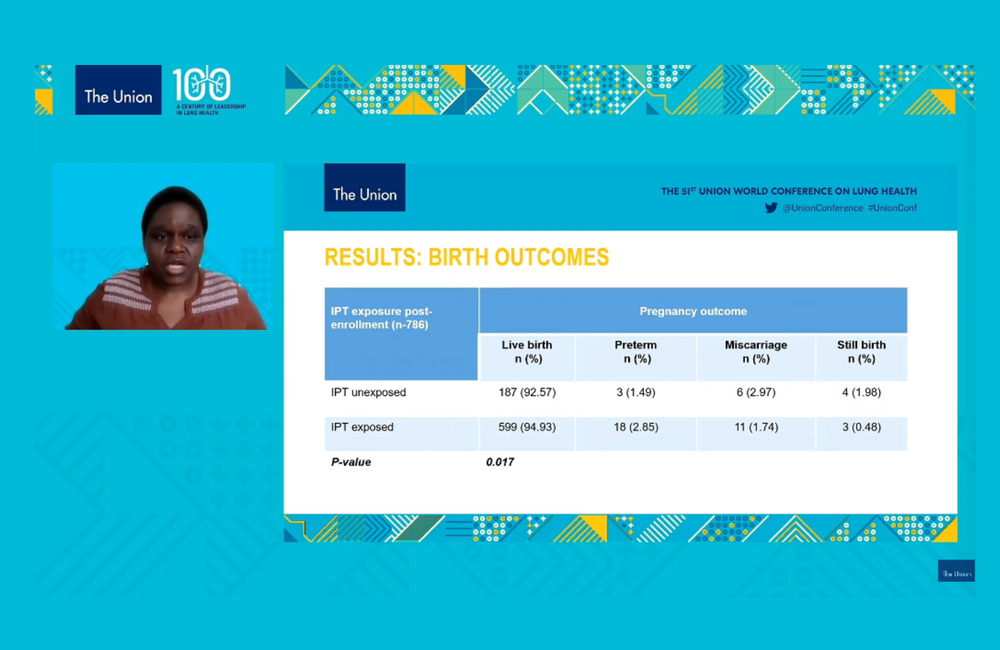
Pregnant women with HIV who took isoniazid to prevent tuberculosis were more likely to have a live birth and less likely to experience a miscarriage, South African researchers reported this week at the Union World Conference On Lung Health.
Another large retrospective study carried out in Kenya found no difference in the risk of premature birth or other adverse birth outcomes between women who started isoniazid preventive therapy (IPT) during pregnancy and those who didn’t.
The two studies provide reassuring evidence that isoniazid preventive treatment does not result in a higher rate of adverse birth outcomes in pregnant women.
Isoniazid is recommended as preventive treatment for TB for people living with HIV at higher risk of TB. However, the trials of IPT in people with HIV that informed World Health Organization guidance excluded pregnant women and the evidence base for the use of IPT in pregnancy is limited.
Some studies have raised concerns that IPT may be associated with adverse birth outcomes for women with HIV. The IMPAACT P1078 TB APPRISE randomised study found that women who started IPT during pregnancy experienced a higher rate of adverse birth outcomes (including stillbirth, spontaneous abortion, low birth weight in an infant, preterm delivery, or congenital anomalies in an infant).
However, programmatic data from South Africa show that IPT reduced the risk of adverse birth outcomes by around 30%.
Pregnancy increases vulnerability to TB disease while maternal TB increases the risk of infant death, prematurity and low birth weight. Gathering further data on adverse birth outcomes in pregnant women with HIV exposed to IPT is therefore a priority for informing decisions about the use of IPT in pregnancy.
South Africa
The South African Medical Research Council carried out a prospective analysis of pregnant women with HIV enrolled in three provinces during 2019, to assess the impact of IPT exposure on birth outcomes.
The study enrolled 1215 women with HIV in the second or third trimester of pregnancy. Sixty-eight per cent started IPT during pregnancy (833 women) and pregnancy outcomes were recorded for 786 women exposed to IPT.
Women exposed to IPT during the second and third trimester of pregnancy were significantly more likely to have a live birth (94.9% vs 92.5%, p = 0.017) and miscarriage was less frequent in IPT-exposed women (1.7% vs 2.9%).
Sikethiwe Masuku of the South African Medical Research Council said that the findings suggest that IPT can be safely used during the second and third trimester of pregnancy. She also warned that recent changes in HIV regimens, alongside greater use of IPT during pregnancy, made it important to evaluate the safety of HIV treatment and IPT during each trimester of pregnancy.
Kenya
Researchers from Emory University, Atlanta, and University of Washington, Seattle, carried out a retrospective chart review of mother-infant pairs at two health facilities in Kisumu province. They identified complete data on IPT exposure and birth outcomes for 576 mother-infant pairs between 2015 and 2020. The study looked at the occurrence of several adverse birth outcomes: low birth weight, congenital abnormality, perinatal death and pre-term birth.
Almost all women were on antiretroviral treatment (99%) and had viral loads suppressed below 1000 copies/ml (90%).
Twenty-seven per cent of women received IPT during pregnancy, starting treatment at a median of 23 weeks of pregnancy.
Pre-term births were somewhat less frequent in women who received IPT. Eighteen per cent of women who took IPT experienced a pre-term birth compared to 22% of women who did not, but this difference was not statistically significant.
The occurrence of the remaining adverse birth outcomes did not differ significantly according to IPT exposure and there was no difference in the risk of a composite adverse birth outcome (any one of low birth weight, congenital abnormality, perinatal death or pre-term birth). An adverse birth outcome occurred in 25.7% of IPT-unexposed births and 22.4% of IPT-exposed births.
Dr Elizabeth Quincer said that ongoing data collection in diverse populations is needed to monitor the effects of IPT exposure in pregnant women with HIV. Larger samples sizes are needed to assess any increased risk of rare birth outcomes including congenital abnormalities, she said.
Masuku S et al. Birth outcomes of pregnant women exposed to isoniazid preventive therapy. 51st Union World Lung Health Conference, abstract OA-01-502-21, 2020.
Quincer E et al. The effect of antenatal isoniazid preventive therapy on birth outcomes in Western Kenya. 51st Union World Lung Health Conference, abstract OA-01-501-21, 2020.

